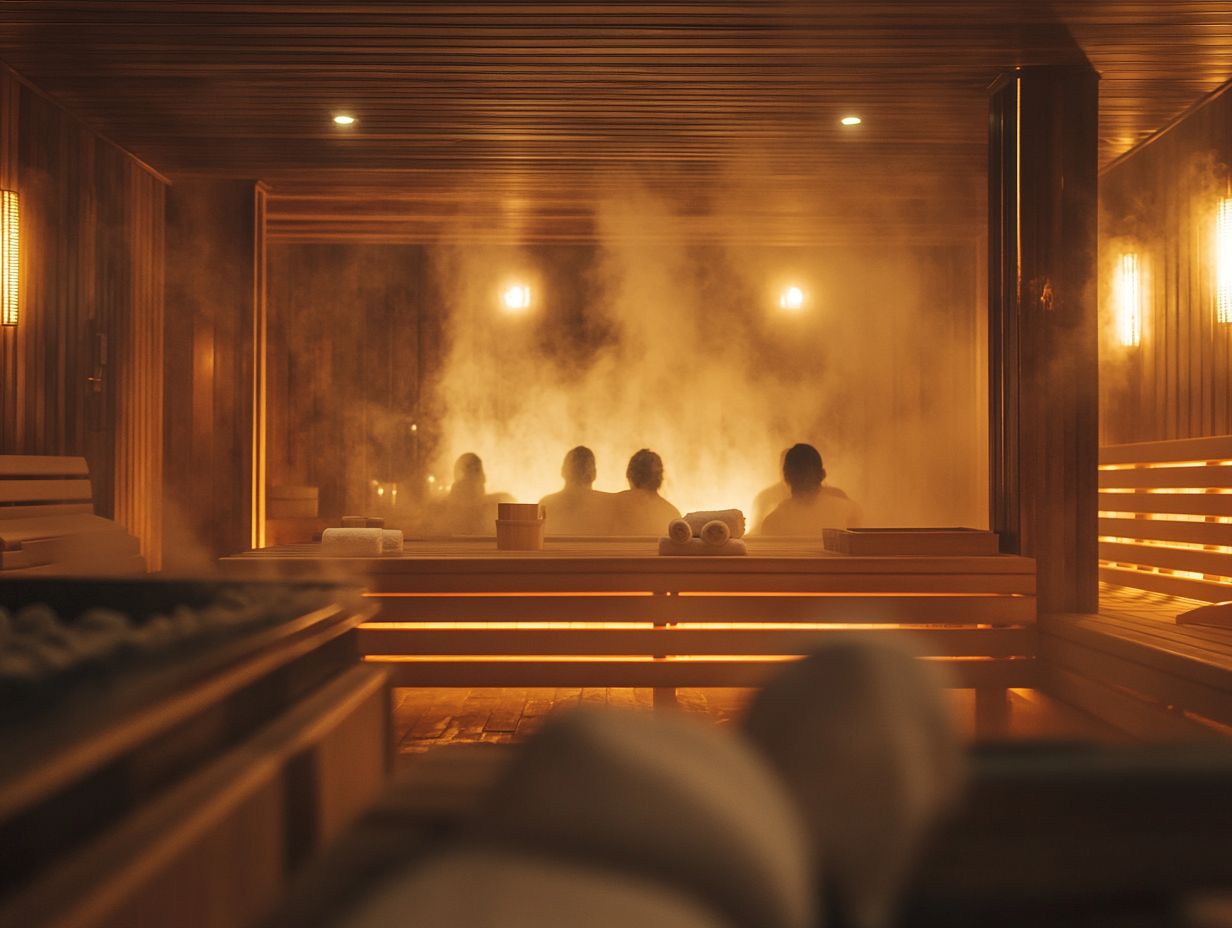Sauna Safety: Building a Culture of Care
Saunas offer a distinctive combination of relaxation and health benefits. Understanding the safety aspects surrounding their use is essential for your well-being.
This guide delves into what saunas are and how they operate. It also highlights the myriad physical and mental health advantages they can provide. It s crucial for you to consider potential risks and learn how to mitigate them.
From best practices for sauna owners to essential safety precautions for users, this guide helps you embrace safety for an unforgettable sauna experience!
Dive in with us as we reveal everything you need to ensure a safe and rejuvenating sauna experience.
Contents
- Key Takeaways:
- Understanding Sauna Safety
- Benefits of Sauna Use
- Potential Risks of Sauna Use
- Creating a Culture of Safety in Saunas
- Safety Precautions for Sauna Use
- Emergency Preparedness in Saunas
- Frequently Asked Questions
- What is sauna safety and why is it important?
- What are some common safety guidelines to follow when using a sauna?
- How can sauna safety be incorporated into a culture of care?
- What should I do if I start feeling unwell during a sauna session?
- Are there safety precautions for pregnant women or people with medical conditions?
- What hazards should I watch for in a sauna?
Key Takeaways:

- Learn about saunas and their risks.
- Create a safe sauna environment.
- Be prepared for emergencies to ensure the well-being of all users.
Understanding Sauna Safety
Understanding sauna safety is essential for you if you wish to fully embrace the multitude of benefits that this wellness tradition offers. Saunas have woven themselves into cultures globally, particularly in Finland, where they are revered for their role in relaxation and health.
Saunas can enhance both your physical and mental well-being. It’s crucial to follow safety protocols to avoid risks like dehydration, overheating, or even mould growth.
To ensure a safe sauna experience, make regular inspections a priority, guarantee adequate ventilation, and adhere to established sauna guidelines.
What is a Sauna and How it Works
A sauna is a cozy retreat crafted to envelop you in high temperatures, typically heated by wood-burning stoves or a type of heating that uses light to warm the body. Here, you can unwind and revel in the myriad benefits of heat therapy.
The essence of thermal spas stems from sauna experiences, focusing on relaxation, detoxification, and overall wellness. These spaces are meticulously designed to encourage deep sweating, which assists in flushing out toxins and boosting circulation.
Traditional wood-burning saunas radiate warmth through heated stones, offering a rustic charm, while infrared saunas employ light to directly warm your body, delivering effective treatment at lower temperatures.
No matter which you choose, the heat invites your body to release endorphins, elevating your mood and alleviating stress. Regular visits can enhance respiratory function and improve skin health, underscoring that these therapeutic havens provide not only physical benefits but also profound psychological relief.
Benefits of Sauna Use
The benefits of using a sauna go far beyond simple relaxation; they encompass a range of health and fitness advantages that significantly enhance your overall well-being.
By incorporating regular sauna sessions into your routine, you can improve your cardiovascular health, support detoxification processes, and boost mental clarity all contributing to a more holistic approach to wellness.
Start enjoying the benefits of saunas today safely and joyfully!
Physical and Mental Health Benefits
Using a sauna offers a wealth of physical and mental health benefits, such as improved blood circulation and enhanced relaxation. This makes it an essential element of any wellness regimen you choose. The heat from the sauna helps in removing toxins from the body while providing a serene escape for your mind.
Research shows that regular sauna sessions significantly enhance circulation by dilating blood vessels, which boosts oxygen flow throughout your body. This improved circulation facilitates faster muscle recovery, especially beneficial for athletes, and aids in flushing out toxins. However, it’s essential to prioritize sauna safety, promoting overall well-being.
In terms of mental health, sauna usage has been linked to reduced levels of cortisol, the stress hormone. This allows you to experience heightened feelings of relaxation and tranquility. Many personal testimonials highlight the profoundly rejuvenating experience of emerging from a sauna, describing a deep sense of calm and relief from daily stresses. However, it’s important to prioritize safety; understanding sauna safety and the role of first aid training can enhance your experience.
Experts, including psychologists and fitness specialists, strongly recommend incorporating sauna sessions into your regular health routine to fully harness these holistic benefits. To ensure a safe experience, it’s important to follow sauna safety practices.
Potential Risks of Sauna Use

Saunas have many health benefits, but you should know the potential risks to ensure your safety during your sessions. Risks such as dehydration, overheating, and burns can arise if sauna protocols aren t followed.
This highlights the necessity of understanding these potential dangers to fully enjoy your sauna experience.
Identifying and Addressing Risks
Identifying and addressing the risks associated with sauna use is crucial for ensuring a safe and enjoyable experience. One primary concern is dehydration, which you can manage by maintaining proper hydration levels before, during, and after your sauna sessions.
Be vigilant about the signs of overheating. Excessive exposure to high temperatures can lead to serious health issues, so it’s essential to monitor your time inside and listen to your body. Familiarizing yourself with sauna safety regulations can further help ensure a safe experience. If you ever feel faint or unwell, exit the sauna immediately.
Understanding and following established sauna rules like showering before entry and avoiding alcohol consumption is vital for creating a secure environment. Additionally, recognizing sauna safety practices, including regular checks, can foster a culture of safety and awareness. This way, you can fully enjoy the numerous health benefits that sauna sessions offer while minimizing potential hazards.
Creating a Culture of Safety in Saunas
Creating a culture of safety in saunas is essential for promoting well-being and enhancing enjoyment for every user while effectively minimizing risks. This involves implementing established sauna rules and ensuring regular maintenance.
By fostering an environment where safety is prioritized, you enhance the overall experience, making each session both enjoyable and secure.
Best Practices for Sauna Owners and Users
Implementing best practices for sauna owners and users is crucial for ensuring a safe and enjoyable experience while promoting the longevity of the sauna itself. Key practices include regular maintenance, adherence to safety protocols, and educating users about sauna rules.
By prioritizing these elements, you create an inviting atmosphere while minimizing risks associated with sauna use. For those new to the experience, preparing for your first sauna session is crucial. Regularly checking high temperatures and humidity levels is essential, as overheating can lead to serious health hazards.
Users must understand the significance of proper hydration before and during their sauna session, as dehydration can compromise well-being. Being aware of time limits typically recommended at no more than 15-20 minutes ensures both comfort and safety. For families, following sauna safety guidelines is crucial to enhancing the experience.
Embracing a culture of respect for these practices not only enhances your experience but also aligns with established industry standards, fostering a community of informed sauna enthusiasts. For more insights on this topic, explore sauna safety and mindfulness. Act now to ensure your sauna sessions are safe and enjoyable.
Safety Precautions for Sauna Use
Safety precautions for sauna use are essential for safeguarding your health and well-being, particularly when it comes to temperature settings and session duration. By adhering to established guidelines, you can effectively reduce risks like dehydration and overheating. This ensures that your sauna experience is both enjoyable and safe.
Guidelines for Sauna Temperature and Duration

Establishing clear guidelines for sauna temperature and duration is essential for ensuring your sauna experience is both safe and effective. Recommended temperatures typically range from 150 F to 195 F, with sessions lasting between 15 to 20 minutes to prevent overheating.
Health experts emphasize that you should always listen to your body during these sessions. If you’re a beginner, getting used to higher temperatures is key. Try shorter visits more often, allowing ample time for recovery between sessions. Stay hydrated! It’s vital for your sauna experience; make it a habit to drink water before and after to replenish those lost fluids, as perspiration can be quite intense. Additionally, understanding sauna safety and the impact of emotion can enhance your overall well-being during these sessions.
Pay attention to your comfort levels. If you start feeling dizzy or uncomfortable, it’s best to exit the sauna right away. Incorporating regular breaks and cooling periods not only enhances your overall experience but also ensures your safety and well-being. For more information, check out sauna safety tips to help build a culture of wellness.
Emergency Preparedness in Saunas
Emergency preparedness in saunas is essential for you to effectively respond to accidents or emergencies, ensuring the safety of everyone involved. Prioritizing these measures makes your sauna experience safer and more enjoyable!
What to Do in Case of Accidents or Emergencies
If there is an accident in a sauna, your knowledge of the correct response protocols can be the pivotal factor between providing effective assistance or inadvertently making the situation worse. Immediate action, coupled with established safety measures, is essential for safeguarding everyone’s well-being.
To navigate these incidents with confidence, it s crucial for you and the staff to familiarize yourselves with common emergencies, ranging from heat-related illnesses to slips and falls. First and foremost, assessing the injured person’s condition is vital. If someone is fainting or experiencing severe dizziness, moving them to a cooler, well-ventilated space can be key to stabilizing their health.
Have clear access to first aid kits and know how to quickly contact emergency services as this can save precious time. Engaging in regular safety drills and training sessions will equip you with the necessary skills to react calmly and efficiently, ultimately creating a safer environment for all sauna patrons.
Frequently Asked Questions
What is sauna safety and why is it important?
Sauna safety means taking steps to protect yourself while enjoying the heat! It is important because saunas can pose potential risks if not used properly, and prioritizing safety can prevent injuries and accidents from occurring.
What are some common safety guidelines to follow when using a sauna?

- Limit sessions to 15-20 minutes.
- Stay hydrated.
- Avoid alcohol and drugs before or during sauna use.
- Never use a sauna alone or when feeling unwell.
How can sauna safety be incorporated into a culture of care?
A culture of care in relation to sauna safety involves creating an environment where everyone is responsible for their own safety and the safety of others. This can be achieved by educating individuals on proper sauna use, providing clear safety guidelines, and promoting open communication about safety concerns.
What should I do if I start feeling unwell during a sauna session?
If you feel unwell during a sauna, leave immediately and cool down. Seek medical attention if necessary. Having a sauna buddy can help monitor your well-being.
Are there safety precautions for pregnant women or people with medical conditions?
Pregnant women should avoid saunas. People with conditions like heart disease or high blood pressure should consult their doctor before using a sauna.
What hazards should I watch for in a sauna?
Be aware of hazards like overheating, dehydration, slips, and electrical malfunctions. Taking precautions can help keep you safe.






